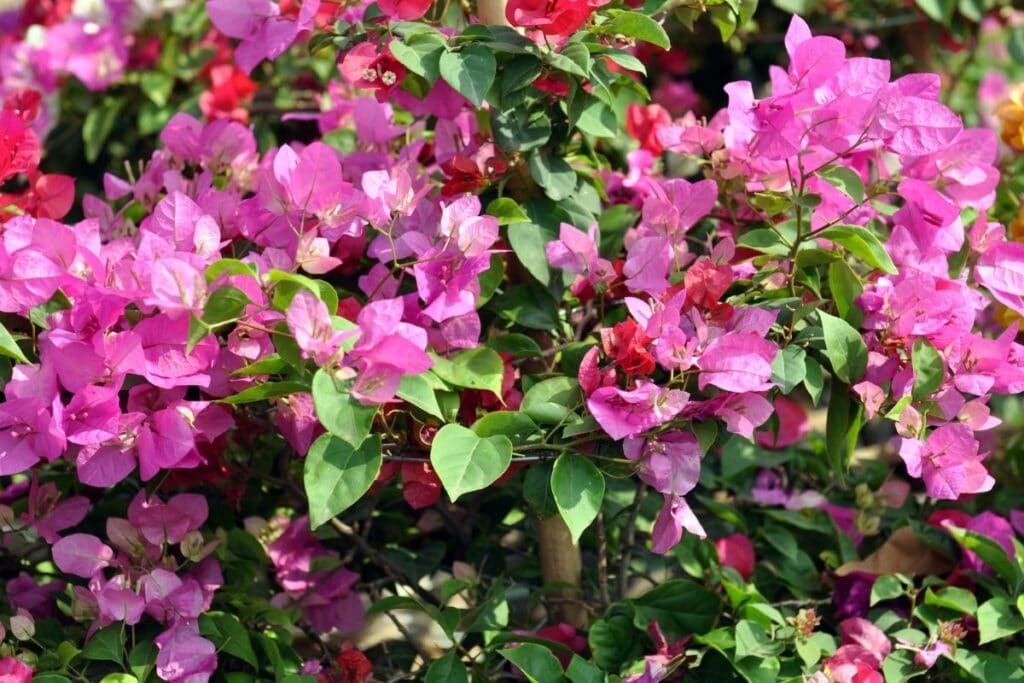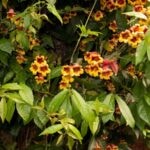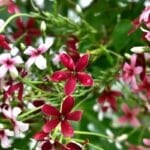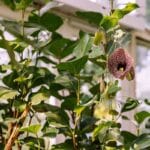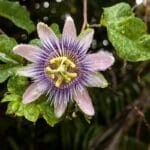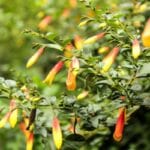The Bougainvillea plants will surely tick the right boxes from beauty to functionality. They are sturdy, low maintenance, and easy to grow. In addition, their blooms and vibrant bracts will attract anyone, thanks to their specialized structure that makes them more noticeable.
Botanical Information
The Bougainvillea plants, Bougainvillea sp., are also called Great Bougainvillea and Paper Flower. The plant is named after a French military commander and navigator, Louis Antoine de Bougainville, who gave the spotlight for this plant in 1768
Coming from the Nyctaginaceae family, this plant is one of the most versatile plants as it can serve as a screen, shade, and accent, thanks to its growth habits and morphological characteristics. Various crosses were done to produce more varieties and improve their characteristics
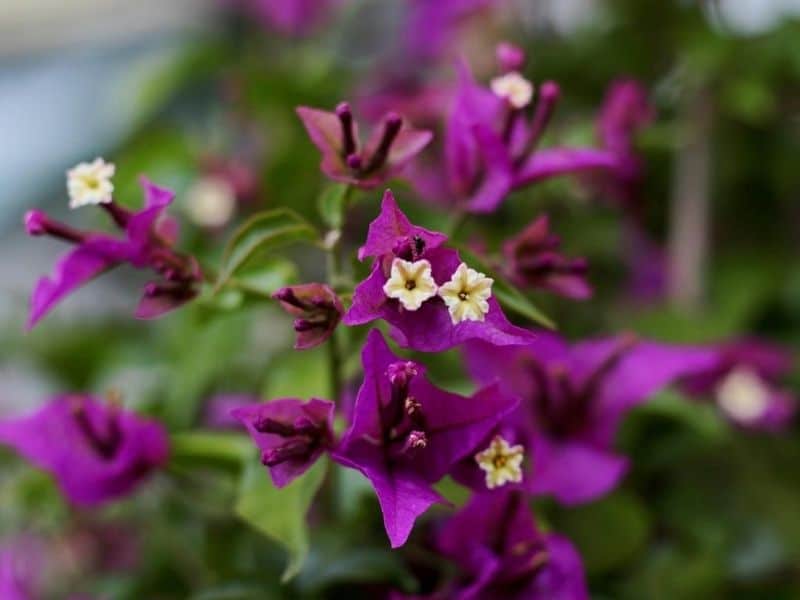
Spatial Distribution
Bougainvilleas originated in South America and love to grow in coastal areas. It can also survive in USDA Zones 9 to 11. They grow best in Zone 10 but can also flourish in Zone 9 as long as they are tended.
In colder climates, they become houseplants planted in pots and greenhouses to survive in hardiness zones 7 and 8 or around South Carolina.
They can also be found in different countries in Asia, Africa, West Indies, Mediterranean Regions, and Tropical America. In general, the Bougainvillea plants prefer to live in places with warm temperate and tropical climates.
Leaves
The Bougainvillea species share similar leaf structures as they produce evergreen broadleaves. Commonly mistaken as their flowers, their bracts are the colorful eye-catching parts that we often see.
Bracts are specialized leaves and depending on the variety, their bracts vary in color, such as green, orange, pink, purple, red, white, orange, and yellow. Its leaves are arranged alternately with a simple ovate shape with a wavy leaf margin. Also, the leaves are papery or leathery that grows up to 3 inches in length and width.
Accompanied with soft hairs, known as trichomes, on the lower parts of the petioles, its leaves are attached to their brown branches which also have trichomes and needle-like thorns on the leaf axils.
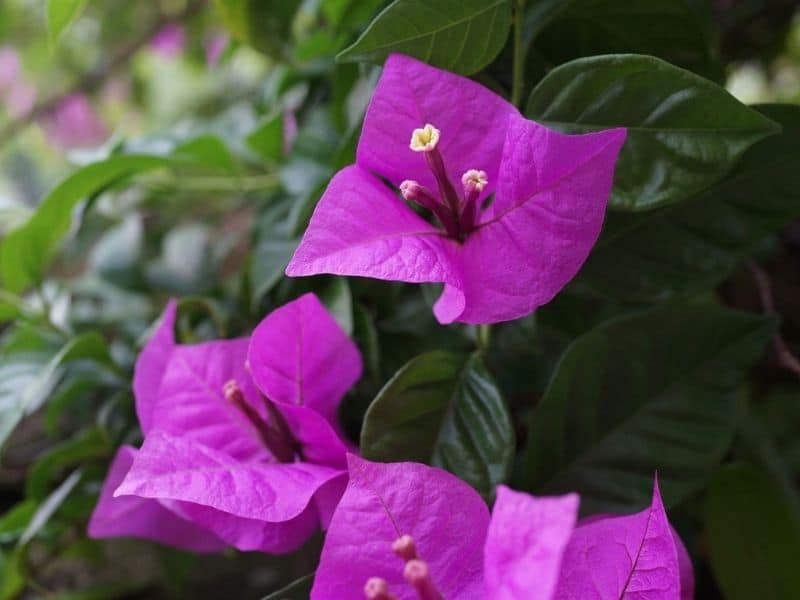
Bougainvillea Flowers
The real flowers of Bougainvillea plant are usually surrounded by three to four colorful bracts. They are small tubular flowers that are less than an inch long with 5 to 10 stamens. Their lobes have the same color with its bracts but a little lighter as it transitions to white or cream-colored petals.
Fruit
After flowering, winged achenes or a small dried fruit around 1 to 1.5 cm long with 5 ridges encapsulates a seed. Seeds are commonly spread through environmental agents, such as wind and water.
Growth and Development
The Paper Flower grows vastly since it is a vine-like shrub. Its stems can intertwine and form a pseudo-trunk making it look like a shrub or a little tree. Once established, its stems turn woody and support itself.
In some gardens, these tropical plants are grown in big planter boxes or dishes and placed as a specimens. Given the right conditions, it can grow up to 6 feet in one growing season.
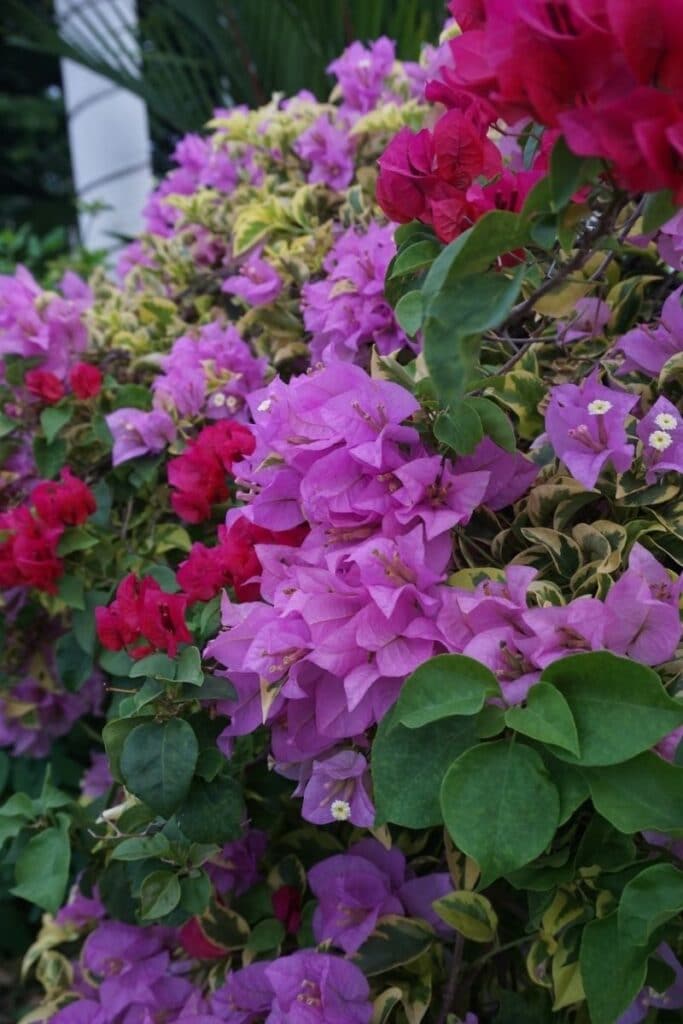
Growing and Caring Tips for Bougainvillea
Sunlight Requirement
Different species and varieties of the Great Bougainvillea share a common love for the sun. Although they can be grown under partial shade, their growth will be optimized if exposed to full sunlight.
At least 6 hours of uninterrupted sunlight exposure is beneficial for the production of flowers and their colorful bracts. If fewer hours of exposure are given, leaves may be healthy and dark green but flowers rarely develop.
Water Requirement
Watering plants is not as simple as it seems. The person to perform watering should be knowledgeable of the plants’ moisture requirements and have a keen eye for symptoms of wilting and discolorations. Bougainvilleas do not require much water but it loves a moist environment. More frequent watering is recommended on hotter days.
Watering can also induce flowering in cases where the plant produces fewer flowers than expected. Observing the soil and waiting for it to dry, causing the plant to almost wilt, then the usual watering schedule and amount should commence.
Soil Requirement
The best soil for this plant is characterized by having porous well-drained and not too compact soil. Some grow Paper Flowers in soilless media, as long as the drainage is good. When planting in containers or pots, saucers are advised to be removed to not keep stagnant water.
Temperature
As a sun-loving plant and a hardy tropical vine, the Bougainvillea bush tolerates drought and extreme heat. However, it grows best when the temperature is around 21 to 29 degrees Celsius during the day and 15 to 21 degrees Celsius at night.
During winter, a light frost will not harm the plant but its bracts might start to fall off. Its growth may also be slower than usual and regrowth can be expected as long as there are no serious frost damages on the plant.
Fertilizer Application
Although soils with high organic matter are already good for most plants, including Bougainvilleas, it is also beneficial to apply fertilizers especially if better blooms are expected. Fertilizers that are rich in phosphorus and nitrogen will encourage flower production but would have a counteract if applied excessively.
Adding the aforementioned fertilizers with a micronutrient blend may also be done, especially because Magnesium and Iron deficiencies are relatively common. Remember to follow the recommended application rates written on product labels to avoid toxicity.
Pruning
As a fast grower, overcrowding easily occurs and may cause problems in the plant itself or the landscape. Pruning of unwanted shoots, dried plant parts, and water sprouts will replenish the plant and induce better growth.
In landscape maintenance schedules, pruning should be done regularly, particularly after flowering. It can be accompanied by pinching to produce more blooms. To train the plant, reducing its size by cutting back to a third and removal of undesired and dried parts will make it easier to manage.
Propagation
Propagation of Bougainvilleas is possible through planting seeds, stem cuttings, leaf bud cuttings, and grafting. The most straightforward way is through seeds because it does not require any dormancy breaking activities.
On the other hand, stem cuttings would require a bit more effort than planting seeds. Choosing the right planting bougainvillea material is crucial for a low mortality rate in this propagation method. Matured wood stems, maturing stems, and softwood terminal stems are viable options as long as they are at least eight inches thick with three to five nodes.
Two to four leaves may be kept but the general rule is that there should be enough leaves to optimize photosynthesis but lower transpiration during rooting. Application of root hormones in the right amounts and planting the cuttings in a well-drained rooting medium will ensure the development of roots after around 4 to 12 weeks after sowing.
Similar to stem cuttings are leaf-bud cuttings, wherein the difference is the planting material to be used. In leaf-bud cuttings, axillary buds along with short parts of the stem are used. This method is commonly done when the mother plant is not lush enough to supply much.
Lastly, there are instances wherein cuttings will not be possible due to having low chlorophyll content in leaves in some cultivars. Grafting is the perfect method for such. The main things to consider are having a stable and strong rootstock and a disease-free scion.
In transplanting, dipping in fungicides may be done to make sure that the plants will grow disease-free.
Problems Frequently Encountered
Oftentimes, Bougainvilleas get infected with bacterial leaf spots and fungal diseases. Also, mealybugs, aphids, and scale insects may cause havoc on the plant. Chemical treatments may be applied in the right amounts.
Proper maintenance procedures may prevent the presence of pests. Pruning will help lessen the plant’s susceptibility since it will not only remove dead plant parts but also improve ventilation.
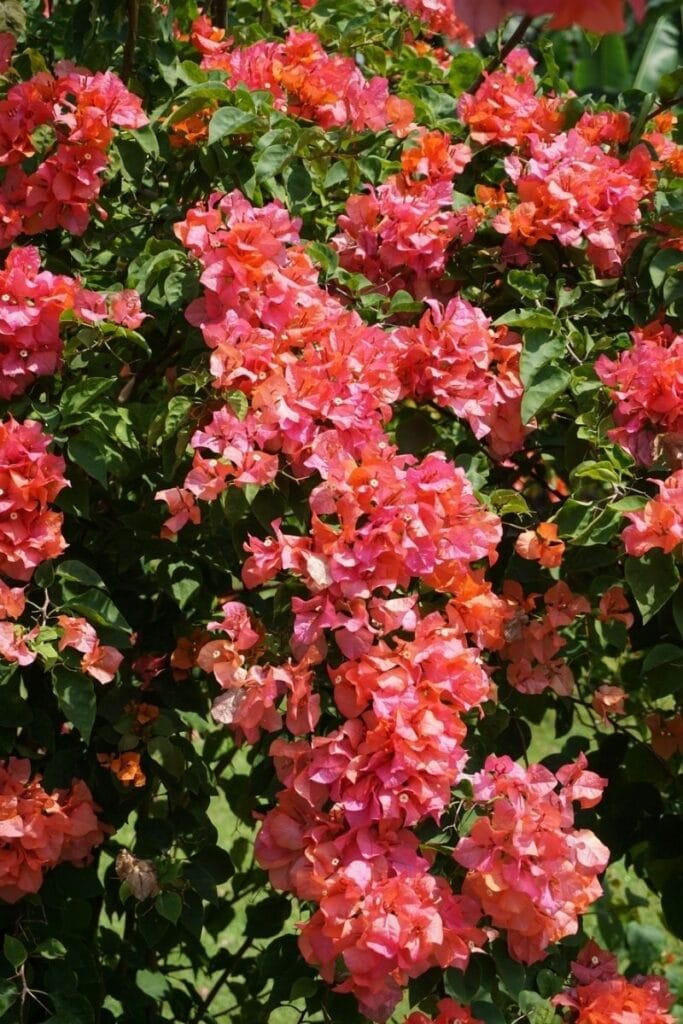
Top 3 Most Common Bougainvillea Species You Can Grow
Bougainvillea spectabilis
Carl Ludwig Willdenow, a German Botanist, was given the credit for the identification of this species. It is differentiated by its red to red-violet bracts surrounding a cream-colored flower. Its leaves are dense and slightly bigger than those of the other species. Usually, this plant blooms after long dry periods and blooms on both upper and lower parts of the plant.
Bougainvillea peruviana
The B. peruviana was first identified by a German explorer and naturalist, Alexander von Humboldt, in 1810. It has a distinctive green bark with thin elongated glabrous leaves. Around its yellow flowers are rounded pink to magenta-colored bracts that may sometimes be wrinkled. Its sharp thorns are shorter and straighter than other species. This bougainvillea vine is known to be the most stable species of Bougainvillea.
Bougainvillea glabra
Coming from Brazil, Swiss botanist Jacques Denys Choisy first identified this species in 1850. It differs from others due to its glossy and elliptical appearance of leaves that are green or variegated.
Trichomes are rarely found in this species. Its bracts are usually triangular but vary in color from white, purple, or mauve surrounding a white flower. The bracts and flowers usually appear on the tips of the stems. Blooms are seen during different seasons throughout the year.

7 Common Cultivars of Bougainvilleas
‘Mrs. Butt’
This cultivar is highly utilized in landscapes for its peach to red-colored bracts. It is from buttiana and it blooms repeatedly in season.
‘Juanita Hatten’
The Juanita Hatten cultivar is perfect to be planted in hanging baskets as its stems will branch freely. Also, its bracts vary in color from red to variegated green.
‘California Gold’
The California Gold got its name from its large yellow gold bracts. This cultivar also acts more as a woody vine and is usually used in landscapes.
‘Royal Purple’
This cultivar thrives in humid areas and gives off dark purple bracts. If you want to grow a climbing plant with purple flowers, this one is for you.
‘Vicky’
With its distinctive pink bracts with yellowish-white flowers, this cultivar is one designed to be a specimen plant.
‘Golden Summer’
This cultivar produces blooms multiple times with white to variegated gold bracts.
‘Double Pink’
Belonging to the repeat bloomers, this cultivar produces massive clusters of pink doubles.
Bougainvillea’s Roles in a Landscape
With its colorful and showy bracts and aggressive growth, Bougainvillea is an ideal plant in the landscape as it can add color and does not require laborious maintenance activities. It can act as a hedge, screen, specimen, and accent in a landscape. It can also be grown as a flowering bonsai.
Remember to plant it in dry areas and in direct sunlight if blooms are desired. Incorporating it in pergolas and arbors is done to provide extra shade. To prove its versatility, it can also be planted in containers and hanging pots.
FAQs
How do you keep bougainvillea blooming?
To keep Bougainvillea blooming, provide it with full sunlight, well-draining soil, and avoid over-fertilization, as too much nitrogen can reduce flowering. Pruning spent flowers regularly can also encourage new blooms.
Can a bougainvillea get too much sun?
Bougainvillea thrives in full sunlight but can tolerate partial shade. While it loves sun, excessive heat without adequate moisture can stress the plant.
What are the disadvantages of bougainvillea?
Some potential disadvantages of Bougainvillea include its thorny nature, rapid growth that may require frequent pruning, and susceptibility to pests like aphids. Additionally, the plant can be messy with fallen bracts and leaves.
How do you make bougainvillea bushy?
Pruning Bougainvillea can promote bushiness. Pinch or trim the tips regularly to encourage lateral branching. Additionally, avoid over-fertilization with high-nitrogen fertilizers, as this can lead to excessive vegetative growth at the expense of flowering.
Don’t forget to check more shrubs and vines you can grow on our blog!
*image by an_chicago_2016 & mangkelin1/depositphotos

